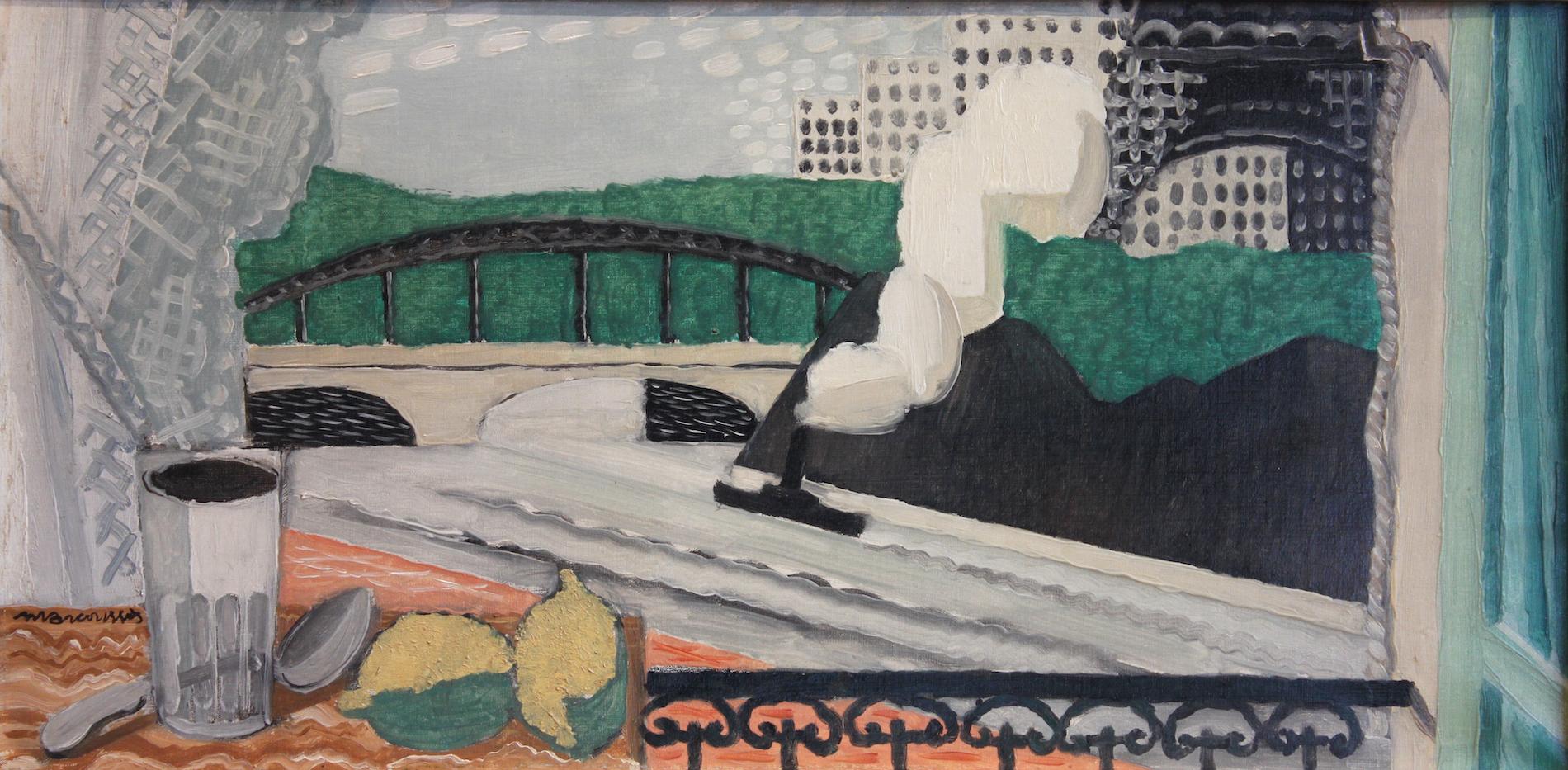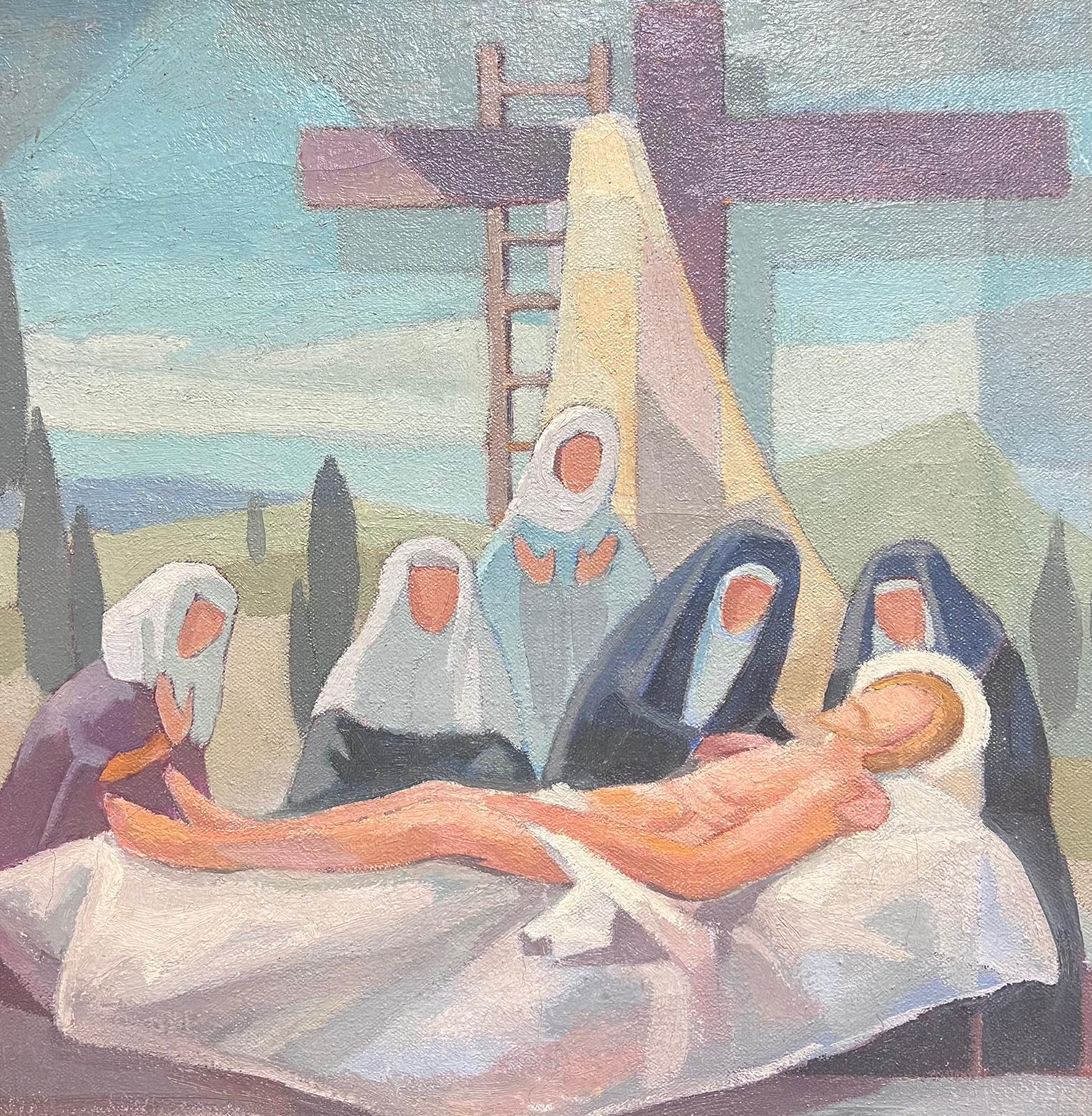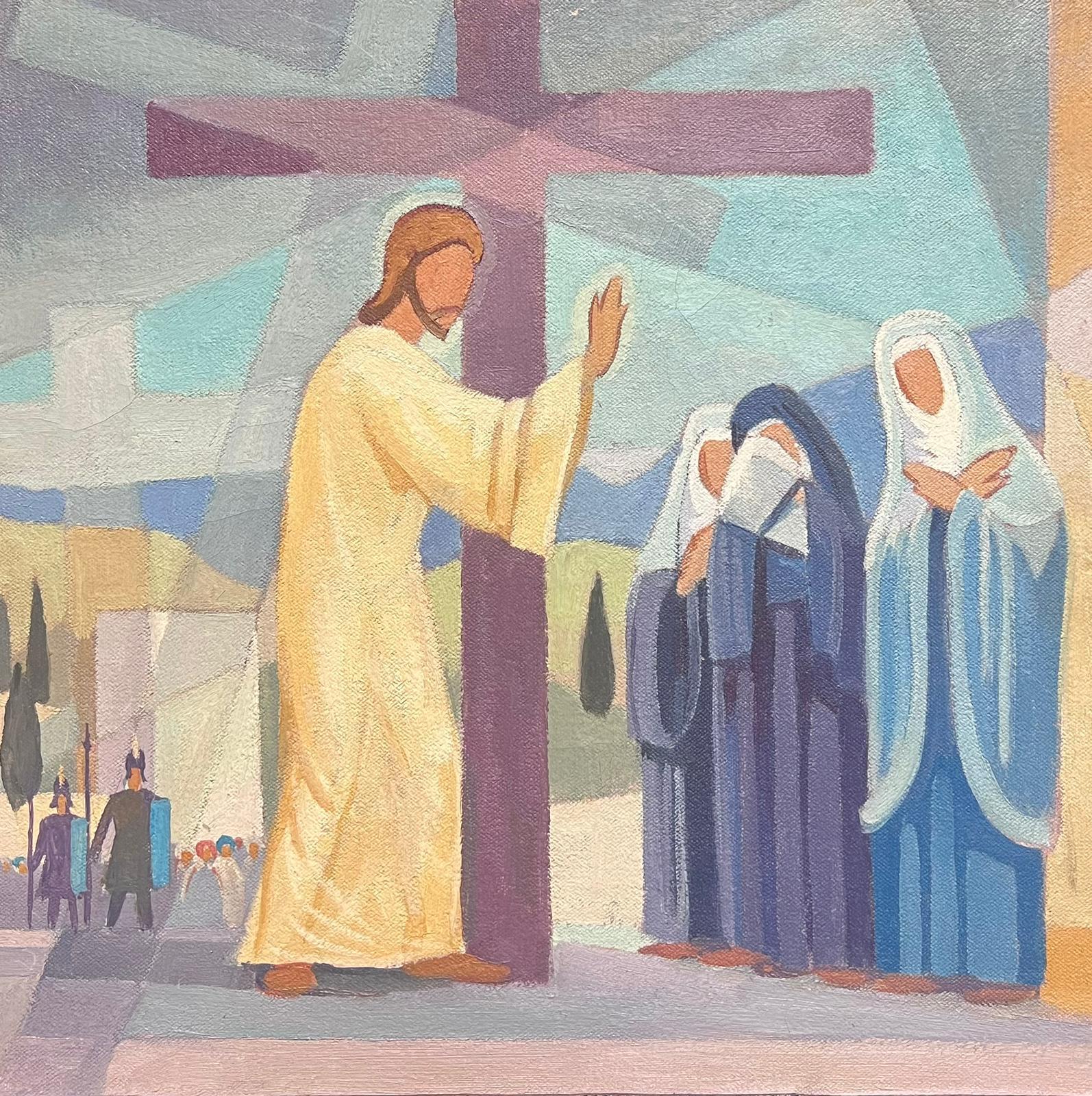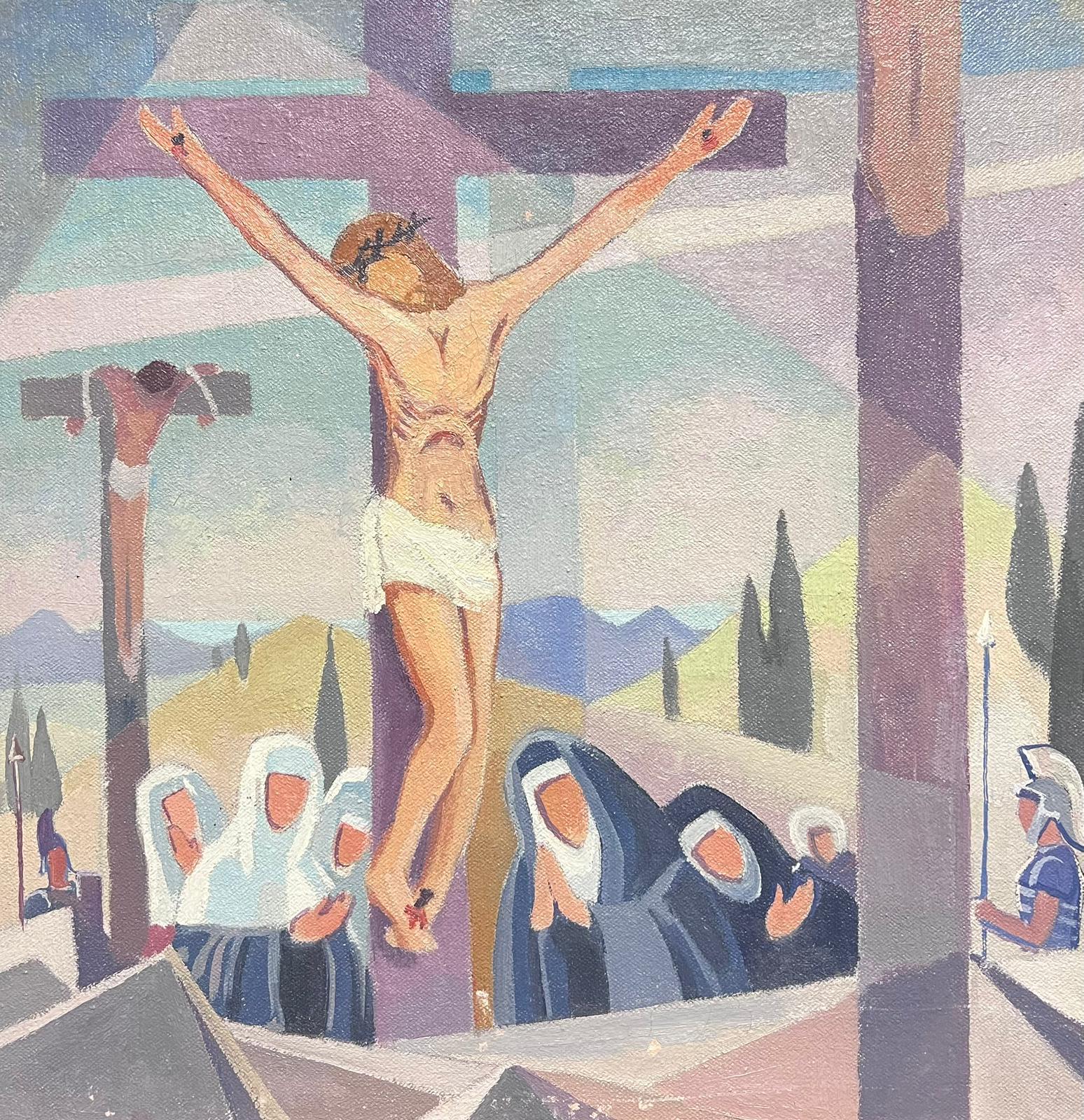Items Similar to Vallee du Cousin - French Cubist Oil, Green River Landscape by Camille Hilaire
Want more images or videos?
Request additional images or videos from the seller
1 of 16
Camille HilaireVallee du Cousin - French Cubist Oil, Green River Landscape by Camille Hilairec.1960
c.1960
About the Item
Stunning signed oil on canvas landscape circa 1950 by French cubist painter Camile Hilaire. The piece beautifully depicts trees reflecting in the water of a river. The painting is painted in wonderful greens and yellows with grey tree trunks and splashes of blue in the shadows and the water below. The piece was painted in the Vallee de Cousin is located near Avallon in the Yonne region of France.
Signature:
Signed lower right
Dimensions:
Frame: 29"x34"
Unframed: 21"x26"
Provenance:
Private French collection
Camille Hilaire was a pupil at the École des Beaux-Arts in Paris. He also worked in the free academies, including that of André Lhote, whose teaching had a major influence on his work.
He executed numerous mural decorations, tapestries, stained glass windows and mosaics for embassies, cruise liners and public buildings, especially in Nancy. His work was abundant and clearly decorative in a style of Post-Cubist construction with a broad range of colour in acid tones. He is particularly known for his Orchestras, Horse Races and 1950 Greenhouses. He taught at the École des Beaux-Arts first in Nancy, then in Paris.
Camille Hilaire participated in numerous collective exhibitions in Paris including: Salon d'Automne, Salon des Indépendants, Salon des Tuileries, Salon de Mai, Salon des Peintres Témoins de leur Temps. He also exhibited abroad. Solo exhibitions include: Paris (1951, 1957, 1961, 1965); New York (1954 and 1956; Geneva (1958). He received numerous awards: a travel grant from the French State (1947); Venice prize (1949) Antral and Casa Velázquez prizes (1950); Prix de la Société des Amateurs d'Art (1958)
Museum and Gallery Holdings:
Épinal (Mus. départemental d'Art ancien et contemporain): Landscape
Paris (MAMVP)
Paris (MNAM-CCI)
- Creator:Camille Hilaire (1916 - 2004, French)
- Creation Year:c.1960
- Dimensions:Height: 29 in (73.66 cm)Width: 34 in (86.36 cm)
- Medium:
- Movement & Style:
- Period:
- Condition:Very good original condition.
- Gallery Location:Marlow, GB
- Reference Number:
Camille Hilaire
Camille HILAIRE (1916-2004) was a French painter and weaver from Metz in Eastern France. He attended the École des Beaux-Arts in Paris and was also tutored by André Lhote. Camille Hilaire is subtle in his composition. He did away with efficient structures, he held power with colour and achieved a wonderful, consistent sense of calm, amplitude and greatness by translating patterns and elements, which never prevented him from expressing a burning passion for creating and sharing. His nudes were remarkable, with perfect curves, coiled with charm and set in a context in which their sensual fullness imposed itself with provocative grace. As for his landscapes, Camille Hilaire could determine the structure without apparent constraints, overlaying a fresh, spicy green that is so characteristic of them. Thus, nature and elements they become the pretext upon which the artist "pushed" the colour to get the effect felt. Over time, a dozen monographs have been devoted to him as well as documentaries and films. He leaves behind a large body of work who strongly influenced the French painters of the mid-twentieth century.
About the Seller
5.0
Platinum Seller
These expertly vetted sellers are 1stDibs' most experienced sellers and are rated highest by our customers.
Established in 2001
1stDibs seller since 2016
673 sales on 1stDibs
Typical response time: 3 hours
- ShippingRetrieving quote...Ships From: Marlow, United Kingdom
- Return PolicyA return for this item may be initiated within 3 days of delivery.
More From This SellerView All
- La fenetre a Meneaux - French Cubist Landscape Oil Painting by Andre LhoteBy André LhoteLocated in Marlow, BuckinghamshireSigned and dated oil on canvas landscape by French cubist painter André Lhote. The piece depicts a view of a mountainous landscape from a Mullion window - a decorative with a vertica...Category
1950s Cubist Landscape Paintings
MaterialsCanvas, Oil
- Vieux palais sur la canal - Venice - Cubist Landscape Oil by Camille HilaireBy Camille HilaireLocated in Marlow, BuckinghamshireSigned and titled cubist oil on canvas circa 1980 by French painter Camille Hilaire. This wonderful and colourful piece depicts a gondola on the Grand Canal, Venice with old palace behind. Signature: Signed lower right and titled verso Dimensions: Framed size: 21"x24" (53.3cm x 61.0cm) Size: 15"x18" (38.1cm x 45.7cm) Provenance: Private French collection Camille Hilaire was a pupil at the École des Beaux-Arts in Paris. He also worked in the free academies, including that of André Lhote, whose teaching had a major influence on his work. He executed numerous mural decorations...Category
1980s Cubist Landscape Paintings
MaterialsCanvas, Oil
- L'etang bleu - Cubist Landscape Oil Painting by Camille HilaireBy Camille HilaireLocated in Marlow, BuckinghamshireSigned and titled oil on canvas landscape circa 1980 by French cubist painter Camile Hilaire. The work beautifully depicts a pond surrounded by foliage. The piece is painted in wonde...Category
1980s Cubist Landscape Paintings
MaterialsCanvas, Oil
- Barques de Peche - Post Impressionist Landscape Oil by Henri Le SidanerBy Henri Le SidanerLocated in Marlow, BuckinghamshireSigned post impressionist landscape oil on canvas by French painter Henri Le Sidaner. This stunning piece depicts two fishing boats moored in a fishing village at sunset. The last l...Category
1890s Post-Impressionist Landscape Paintings
MaterialsOil, Canvas
- Pont Neuf - Evening - 19th Century Oil, Riverscape at Night by A E Othon FrieszBy Achille-Émile Othon FrieszLocated in Marlow, BuckinghamshireTHIS WORK IS CURRENTLY ON LOAN TO THE MUSEUM OF MODERN ART IN LE HAVRE AND IS BEING EXHIBITED IN THEIR ELECTRIC NIGHTS EXHIBITION 2020 A stunning oil on original canvas by Achile-Emile Othon Friesz depicting a night time view of the Pont Neuf bridge over the Seine, Paris. The painting shows deep blues and reds - richer than those of traditional impressionist paintings - and shows the transition into Fauvism. Signed and dated 1903 lower right. Framed dimensions are 24.5 inches high by 20 inches wide. Achille Friesz was the son of a family of sailors from Le Havre. From 1885 he often spent time in Marseilles visiting his maternal uncles. As a child he dreamed of going to sea, but from the age of 12 he developed a passion for art, and after secondary school he attended the École des Beaux-Arts in Le Havre. There, from 1896 to 1898, he studied under Charles-Marie Lhullier who had been a friend of Jongkind and whom, like Dufy and Braque, he remembered fondly throughout his life. Lhullier introduced his students to the work of Chardin, Corot, Géricault and Delacroix. After receiving a bursary from the local authorities in 1898, he went to Paris and, while his friends Matisse, Rouault and Marquet studied under Gustave Moreau, enrolled at the École des Beaux-Arts at the studio of Léon Bonnat, where he was joined by Dufy. However, he scarcely attended the studio, preferring to go to the Louvre and make copies of the works of Clouet, Veronese, Rubens, Claude Lorraine and Delacroix. He did his military service in Paris in 1902 but continued with his art. Around this time he met Camille Pissarro and sought his advice. As a young man he began to make frequent trips away, not necessarily travelling very far, but looking for subjects for his work, usually landscapes. Among the places he visited were the Creuse region around 1903, Antwerp in 1905, returning there with Braque in 1906, and La Ciotat, Cassis and L'Estaque in 1906-1907, again in the company of Braque. In Paris he frequently moved lodgings until 1914. He moved in with Henri Matisse at the Couvent des Oiseaux from 1905-1910, that is to say at the period when Fauvism was at its height. In 1908 he returned to his native Normandy to reimmerse himself in his early environment; he would return to the region throughout his life. He made a trip to Munich with Dufy in 1909, and visited Portugal in 1911-1912 and Belgium in 1912. In 1914 he was called up and assigned to technical services, not being demobilised until March 1919, although he did manage to maintain a certain independence. From 1914 until his death he lived in Paris at 73 Rue Notre-Dame-des-Champs, where he occupied Bouguereau's old studio. He made frequent trips to Cap-Brun near Toulon where, in 1923, he acquired a property called Les Jarres, as well as making numerous visits to Normandy and Le Havre. In 1925 he received the highest commendation at the Carnegie Prize in Pittsburgh for Portrait of the Decorative Artist Paul Paquereau. Also in 1925, at the same time as Matisse, he was made a Chevalier of the Légion d'Honneur, rising to in Officier in 1933 and Commandeur in 1937. He was also made Commander of the Swedish order of Vasa in 1934. Throughout his life, Friesz was a teacher: from 1913 at the Académie Moderne; from 1929 at the Académie Scandinave; and from 1941 until his death at the Académie de la Grande-Chaumière. Alongside his activity as a painter, he illustrated several works of literature, including: in 1920 Le Pacte de l'Écolier Juan by Jules Tellier; in 1924 Échelles de Soie by Jean Pédron; in 1926 Le Jardin sur l'Oronte by Maurice Barrès; in 1926 En Suivant la Seine by Gustave Coquiot; in 1929 Rouen by André Maurois; in 1931 The Song of Songs; in 1934 Poésies by Pierre de Ronsard; in 1945 Le Bouquet de la Mariée by Gabriel-Joseph Gros; in 1947 Paul et Virginie by Bernardin de St-Pierre; in 1949 Le Livre de Job by Pierre Poussard; in 1949 Petronius's Satyricon, and in 1949 a collection of 12 unpublished lithographs for Le Désert de l'Amour by François Mauriac. He also designed several pieces of decorative art: from 1906 to 1909 ceramics executed by Metthey among others; a façade for a private house in Le Havre; a china service for two for the Le Havre writer J.-G. Aubry; vases, dishes and plates; in 1912 four sets for La Lumière by Georges Duhamel, performed at the Odéon; in 1916 a screen for the Le Havre collector Léon Pédron; in 1918 panels for Pédron's dining room; in 1920 a mural entitled Children Dancing (Enfants Dansant); in 1920 Les Volières for the apartment of Vicomte Amédée de Flers; in 1935 Peace (La Paix), a Gobelins tapestry presented by France to the Palais des Nations in Geneva; in 1937 La Seine in collaboration with Dufy for the Palais de Chaillot, with each artist taking half of the river's course - From the Source to Paris by Friesz and From Paris to the Estuary by Dufy. The Fauves were producing Fauve paintings before they knew it: it was not until the critic Louis Vauxcelles saw their work at the Salon des Indépendants in 1905 and mockingly used the word Fauve to describe it that the term was born. It is known that Vlaminck and Derain worked together and that the École de Chatou was composed of just these two artists. Friesz was living with Matisse and after his first trip to Antwerp in 1905, he returned in 1906 with Braque. In 1906-1907 Friesz and Braque went to La Ciotat to paint and there they met up with Matisse. The paintings Friesz produced in Antwerp are Fauve inasmuch as they are painted in pure colours and are more or less free of the divisionism of the Impressionists, although the draughtsmanship is fairly standard; these works include The Port, The Escaut, The Canals, The Dock with Sailing Ships and The Red Slipway. Those of Braque the following year, in particular Terrace on the Escaut, show great similarities with those Friesz painted of the same subject. Friesz was already avoiding the hardness of pure flat tints by graduating them in thin glazes, allowing the whiteness of the canvas to penetrate the transparency, a technique that came to characterise his entire Fauve period. At La Ciotat Friesz and Braque adopted completely different Fauve styles, with Braque composing his paintings on horizontal and vertical orthogonals painted in small, regular, spaced-out touches, whereas Friesz developed his own personal rhythmical style of wide arabesques of colour in works such as The Bec-de-l'Aigle, Women Bathing and L'Estaque. Many of Friesz's Fauve works were produced in the south of France, and his Portrait of Fernand Fleuret also dates from this period. When he returned to Normandy in 1908 the period that he described as his 'return to form' began; with compromise paintings such as Entrance to the Port of Honfleur, Côte de Grâce Landscape, The 'Bains Marie-Christine' in Le Havre and the great compositions characteristic of this period - Autumn Labours, Spring, Fisherman on a Rock and Women Bathing. His draughtsmanship retains something of the rhythm of the Fauve period, his figures following the lines of the landscape and the colour remaining clear and resonant. In 1909 he painted the Cirque Médrano series: The Trapeze Artist, The Clown and The Horsewoman. In the south of France he also painted the Olive Trees series. He made a trip to Munich with Raoul Dufy resulting in Winter in Munich. This was also the year of his first trip to Italy. Boat in a Rocky Inlet of 1910 marks one of the pivotal points between a totally rhythmic drawing style of sensual curves typical of his Fauve period and a reduced palette of muted ochres, browns and blues. From 1910 onwards, the final traces of Fauvism become less and less apparent in his work. His use of colour follows the same course, towards the transcription of reality, with broken tones, ochres and browns. After his demobilisation, as well as in his studio in Paris, Friesz spent time in his house in Toulon, returned to Normandy and Le Havre and continued to make frequent, often local, forays in search of new subjects: in 1919 to Jura, producing the series Forests, Pine Trees, Road in the Snow and Invitation to Skate; in 1920 to Italy producing Piedmont Village, Florence Grape Pickers; in 1920 to Le Havre, producing The Étretat Cliffs, People Bathing at Étretat; in 1923 to his house in Toulon, producing View of Coudon, Women Bathing, Grape Harvesting, Jars; in 1924 he painted the Large Nude (which he exhibited at the Salon d'Automne the same year) and landscapes of Toulon; in 1928 he made a trip to Algiers, producing The Algiers Kasbah and its Phantoms; in 1931 to Annecy, producing Women Bathers by a Lake; in 1934-1935 to Dinan and St-Malo producing The Great Dinan Viaduct, The Dock with the Terre-Neuvas, After Bathing; in 1936 to Honfleur; in 1941-1944, remaining in Paris because of the war, he painted mainly still-lifes, including Studio Corner, Earthenware. In 1946 he returned to Honfleur; and in 1947 to La Rochelle producing The Port Tower, Tuna Boats, The Red Sail. Numerically Friesz's work is dominated by landscapes but it should be remembered that throughout his career he tackled more ambitious compositions and appeared to do so with great ease. These include Boat in a Rocky Inlet of 1910 with its frolicking women bathers, Allegory of War of 1915 executed in 24 hours, Invitation to Skate of 1919, numerous paintings of Women Bathing over several periods and much later Women beside a Pond of 1944, which clearly demonstrates his attachment to Cézanne. He exhibited at the Salon des Artistes Français from 1901 to 1903 and then at the Salon des Artistes Indépendants. From 1906 he exhibited annually at the Salon d'Automne, of which he later became a committee and jury member. In 1923 he took part in the founding of the Salon des Tuileries and became head of two of the Salon's sections. His work has been exhibited at countless group exhibitions all over the world. Among the most recent thematic exhibitions is Fauvism in Black and White. From Gauguin to Vlaminck, Fauvist Engraving and its Setting (Le Fauvisme en Noir et Blanc. De Gauguin à Vlaminck, l'Estampe des Fauves et son Environnement) at the Musée d'Art Moderne in Villeneuve d'Ascq in 2001. He also showed his work in numerous solo exhibitions in Paris: his first in 1904 at the Galerie des Collectionneurs and another the same year at the Société des Peintres du Paris Moderne...Category
Early 1900s Impressionist Landscape Paintings
MaterialsOil, Canvas
- Le Pont de Charenton - Post Impressionist Landscape Oil by Nathan GrunsweighLocated in Marlow, BuckinghamshireSigned post impressionist oil on canvas riverscape circa 1920 but Polish painter Nathan Grunsweigh. The work depicts a view of the bridge over the River Seine in Paris. A beautifully...Category
1920s Post-Impressionist Landscape Paintings
MaterialsCanvas, Oil
You May Also Like
- La Seine et la Tour Eiffel, vue d'un balcon, painting by Louis Marcoussis, 1925By Louis MarcoussisLocated in London, GB*UK BUYERS WILL PAY AN ADDITIONAL 5% IMPORT DUTY ON TOP OF THE ABOVE PRICE La Seine et la Tour Eiffel, vue d'un balcon by Louis Marcoussis (1878-1883) Oil on canvas 33 x 66 cm (13 x 26 inches) Signed lower left, Marcoussis Executed in 1925 Provenance Alice Halicka (the artist's wife), Paris Blanche Fabry Tézé, New York Stern Pissarro Gallery...Category
1920s Cubist Landscape Paintings
MaterialsOil, Canvas
- Miramande Sous La Neige/ Miramande under SnowBy André LhoteLocated in London, GBANDRE LHOTE 1885-1962 Bordeaux 1885 - Paris 1962 (French) Title: Miramande Sous La Neige/ Miramande under Snow, ca. 1933 Technique: Original Signed Oil Painting on canvas ...Category
1930s Cubist Landscape Paintings
MaterialsOil, Canvas
- 1950's French Cubist/ Modernist Oil Painting One of the Stations of the CrossLocated in Cirencester, GloucestershireOne of the Stations of the Cross by Jean La Forgue (French 1901-1975) *see notes below oil painting on canvas, housed in original metal frame overall dimensions: 17 x 17 inches prov...Category
Mid-20th Century Cubist Figurative Paintings
MaterialsCanvas, Oil
- 1950's French Cubist/ Modernist Oil Painting One of the Stations of the CrossLocated in Cirencester, GloucestershireOne of the Stations of the Cross by Jean La Forgue (French 1901-1975) *see notes below oil painting on canvas, housed in original metal frame overall dimensions: 17 x 17 inches prov...Category
Mid-20th Century Cubist Figurative Paintings
MaterialsCanvas, Oil
- 1950's French Cubist/ Modernist Oil Painting One of the Stations of the CrossLocated in Cirencester, GloucestershireOne of the Stations of the Cross by Jean La Forgue (French 1901-1975) *see notes below oil painting on canvas, housed in original metal frame overall dimensions: 17 x 17 inches prov...Category
Mid-20th Century Cubist Figurative Paintings
MaterialsCanvas, Oil
- 1950's French Cubist/ Modernist Oil Painting One of the Stations of the CrossLocated in Cirencester, GloucestershireOne of the Stations of the Cross by Jean La Forgue (French 1901-1975) *see notes below oil painting on canvas, housed in original metal frame overall dimensions: 17 x 17 inches prov...Category
Mid-20th Century Cubist Figurative Paintings
MaterialsCanvas, Oil
Recently Viewed
View AllMore Ways To Browse
Retro French Trunks
Vintage Blue Water Glasses
1950 Water Color Painting
Vintage Green Water Glasses
Mural Tapestry
Acid Green Painting
Stained Glass Window Green
Cruise Liner
Vintage Style Trunks
Horse Tapestry
Venice Tapestry
Tapestry Of Venice
Splashing Water Paintings
Tapestries With Horses
Vintage Cruise Liner
Tree Mosaic
Vintage Horse Races
Grey Horse Oil Paintings






